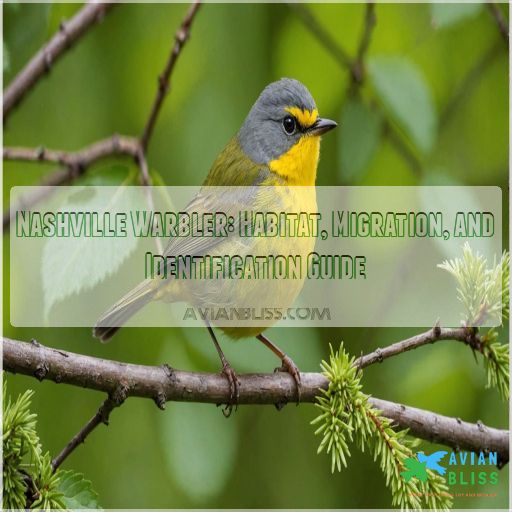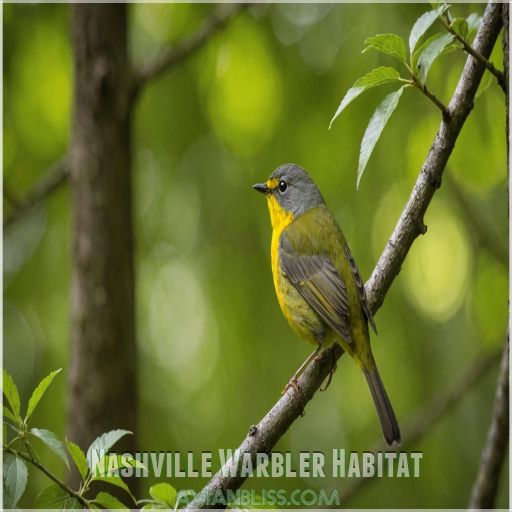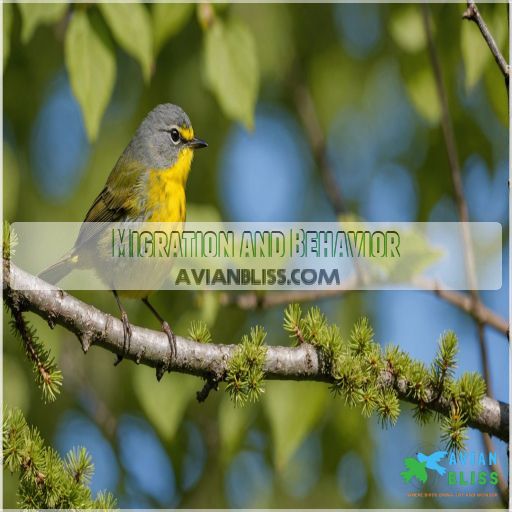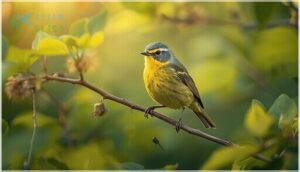This site is supported by our readers. We may earn a commission, at no cost to you, if you purchase through links.

This compact songbird graces us with its presence, flitting through the lush, mixed forests and shrubby thickets across North America.
With its striking olive-green back, bright yellow throat, and distinctive white eye-ring, the Nashville warbler is a real charmer.
These feathered travelers migrate between their northern breeding grounds and southern wintering havens, often traveling in social groups. While they may face challenges like habitat loss, these resilient warblers continue to thrive by mastering the art of efficient foraging and adaptable nesting.
Get ready to spot this dapper little bird on your next competitive birding nature adventure
!
Table Of Contents
- Key Takeaways
- Nashville Warbler Habitat
- Physical Characteristics
- Similar Species Identification
- Migration and Behavior
- Diet and Foraging
- Conservation Status
- Breeding and Nesting
- Frequently Asked Questions (FAQs)
- Where is the Nashville Warbler found?
- What is the difference between a mourning Warbler and a Nashville Warbler?
- What is the difference between a Nashville Warbler and a common yellow throat?
- What looks like a Nashville Warbler?
- What inspired the Nashville Warblers name?
- Are Nashville Warblers affected by climate change?
- Which areas do Nashville Warblers pass during migration?
- What sounds do Nashville Warblers make?
- How do Nashville Warblers care for their young?
- Conclusion
Key Takeaways
- You will recognize the Nashville Warbler by its striking yellow throat and white eye-ring, making it look a bit like it’s wearing spectacles. These little feathered adventurers flit through forests like trapeze artists, showcasing their unique plumage as they migrate across North America.
- During migration, these tiny troubadours travel in social groups, adding a lively chorus to mixed flocks. Their diet is as diverse as a well-stocked buffet, featuring insects like caterpillars but also snacking on berries, seeds, and even nectar when the seasons shift.
- Nashville Warblers face challenges such as habitat loss due to climate change and human impact, similar to finding an empty swing at recess. Despite these hurdles, they continue to thrive, demonstrating adaptability by efficiently foraging and nesting in diverse habitats from cool bogs to warm Mexican forests.
- When these warblers enter the family life, they embrace monogamy, forming tight-knit pairs every breeding season. Imagine this: both parents diligently feed nestlings in well-hidden nests, using teamwork to ensure their chicks grow up to join the next migratory adventure.
Nashville Warbler Habitat
Explore the Nashville Warbler’s home, where it buzzes through delightful woodlands and chilly, shrub-speckled fields.
Whether it’s soaking up the sun in northern bogs or vacationing in Mexico’s mixed forests, it knows how to pick the perfect spot!
Breeding Grounds
The Nashville Warbler’s breeding grounds are found in cool, open mixed forests with plenty of undergrowth.
They favor deciduous, coniferous, and streamside woodlands, as well as bogs and thickets.
In the eastern U.S., they often nest in abandoned fields and mountain pastures with young trees and saplings . Out west, they breed in manzanita and other shrubby habitats near pine and fir belts.
Wintering Habitat
Picture Nashville Warblers spending their winter lounging in low, open deciduous and mixed tropical forests, with threats from climate change tapping lightly on their doors.
These adaptable travelers enjoy suburban gardens too, munching on insects while warming up in the southern United States.
American ornithology delights in their migration patterns and natural history quirks.
Preferred Woodland Types
Imagine you’re exploring the Nashville Warbler’s habitat preferences, and you’ll find they love diverse spots like:
- Forest edges: Where light and shade dance.
- Undergrowth in bog habitats: Moist wonders where bugs thrive.
- Mixed woods: A symphony of coniferous and deciduous trees.
- Scrub and thicket: Perfect nesting and hiding spots.
Nature makes no mistakes!
Geographic Range
Nashville Warblers, found across North America during migration,
can be spotted in cool, open woods from eastern Canada to the Rockies.
Breeding grounds are separate from their wintering locations,
with the latter primarily in Mexico.
Despite their name, these birds are not Nashville natives.
Rather, they pass through the area as part of their migratory journey,
adding diversity and intrigue to their travels – much like a musical journey through unexpected landscapes.
Elevation Preferences
For the Nashville Warbler, elevation impacts its love for mixed and coniferous forests in its breeding range. Although they’re not too picky, these birds enjoy specific altitudes:
- Thrive at moderate elevations.
- Less seen in lowland areas.
- Prefer coniferous-rich habitats.
- Versatile in altitude limits during migration and wintering.
Physical Characteristics
You’ll recognize the Nashville Warbler by its light gray head, contrasting yellow throat, and distinct white eye-ring.
Its compact size and olive back give it a charmingly dapper appearance, making it look like a tiny feathered adventurer on a perpetual nature hike.
Head and Throat Coloration
In your exploration of Nashville Warblers, the head and throat coloration offers a vibrant palette.
Typically, the warbler boasts a gray head with a striking yellow throat, accented by a neat white eye-ring.
There’s a hint of regional and age-related variation, adding personality to each sighting, much like nature’s way of keeping things fresh and interesting!
Back and Wing Color
The Nashville Warbler’s back and wings showcase a lovely olive-green hue, blending seamlessly into the forest canopy.
Their wings feature two distinct white bars, adding a touch of contrast. This camouflage pattern helps them forage efficiently, darting between branches in search of insects.
The plumage can vary slightly between the western "Calaveras" form and the more widespread eastern population , which showcases a slight variation in the species’ plumage.
Tail Shape and Size
Nashville Warblers flaunt a shortish tail, often notched or square-tipped, perfect for their flittering quests through thickets.
Picture tiny trapeze artists, their tail shape aids in balance while bustling for insects.
The "Calaveras" variant sports a longer tail, giving it flair in western habitats.
These tail feather variations reflect subtle adaptations, elegantly suited for survival, and perfectly suited for their flittering quests through thick environments, and is an example of subtle adaptations.
Eye-Ring and Facial Features
You’ve sized up the tail; now cast your gaze to the Nashville Warbler’s face.
That complete white eye-ring’s their key identification feature—it’s like the bird’s got spectacles on, similar to starlings’ iridescent feathers changing season plumage
!
This perfect circle stands out among facial markings, setting them apart from similar species.
Notice that, along with a yellow throat, you’ll easily spot this warbler (Source).
Sex Differences in Plumage
Shifting focus from those distinctive eye features, it’s time to talk sex. Plumage tells a subtle tale between male and female Nashville Warblers:
- Crown color‘s consistency hides any secrets.
- Molt timing reveals seasonal differences.
- Plumage variation fascinates during migration.
- Juvenile plumage mimics adult females closely.
- Even in changing feathers, they’re like undercover stars of the bird world, constantly surprising even the keen observers.
Similar Species Identification
You’ve spotted a little bird with a gray head and bright yellow underside in the woods, and you’re wondering if it’s a Nashville Warbler, which shares the same bright yellow color as other yellow birds
.
Don’t worry, we’ll help you tell it apart from similar birds like the Connecticut, MacGillivray’s, and Mourning Warblers.
So you won’t accidentally blame poor Nancy for those songs Chirpy’s been singing.
Connecticut Warbler Comparison
Spotting the Connecticut Warbler can feel like uncovering a hidden gem.
Unlike the Nashville Warbler, it sports a complete white eye-ring and more terrestrial habits.
While Nashville flits energetically, Connecticut Warblers skulk, moving deliberately with their longer legs and larger, paler bills.
Listen for distinct vocalizations and watch for those unique plumage variations and behavior cues (Source).
MacGillivray’s Warbler Comparison
MacGillivray’s and Nashville Warblers can be a real puzzle. Notice the plumage differences: MacGillivray’s has a gray hood and white lores, while Nashville sports a complete eye-ring and yellow throat.
Size difference is subtle, but behavior helps—Nashville prefers shrubby habitats, whereas MacGillivray’s haunts dense thickets.
Listen for unique songs marking range overlap.
Mourning Warbler Comparison
How do you distinguish the Mourning Warbler from the Nashville Warbler?
While both have gray heads and eye-rings, the Mourning Warbler sports a more uniform yellowish-olive plumage, lacking the Nashville’s contrasting gray head and yellow throat .
The Mourning also tends to be a larger, chunkier bird with a more pronounced bill.
Common Yellowthroat Comparison
Comparing the Nashville Warbler and Common Yellowthroat can feel like choosing between two similar ice creams—you need a taste of their distinctive flavors.
The Nashville sports a gray head with a bright eye-ring, while the Yellowthroat flaunts its bold black mask and yellow throat.
The Nashville Warbler and Common Yellowthroat thrive in overlapping ranges and habitats but varying plumages and foraging habits set them apart , highlighting their unique characteristics in their overlapping ranges.
Key Identification Features
Spotting a Nashville Warbler? Look for its bold white eye-ring and vibrant yellow underparts, perfect for jazzing up gloomy days.
Its olive-green back and distinctive gray head are dead giveaways, while the lack of wingbars adds a minimalist touch.
Keep an eye on its lively tail shape—short and perky, just like that friend who’s always bouncy and upbeat! .
Migration and Behavior
When you’re out birdwatching, keep an eye out for Nashville Warblers as they set off on their long journeys.
They migrate from forests to tropical havens.
These lively birds, who enjoy socializing in mixed flocks, showcase fascinating behaviors from foraging in low branches to their charming seasonal monogamy.
Migration Patterns
You’ve spotted a Nashville Warbler during migration!
These little adventurers journey from Canada’s forests to Mexico, zigzagging around the Gulf instead of soaring over it.
Their migration timing coincides with the fall and spring seasons.
Keep your ears open for their unique song and look out for them flitting through shrubby stopover locations (Source).
Foraging Habits
In migration, Nashville Warblers are like bustling detectives, using their sharp eyes and quick movements to uncover hidden insects among leaves.
Their foraging techniques are adaptable, influenced by habitat and seasons, and they skillfully avoid predators.
These warblers enjoy a diet variation that’s almost gourmet: from beetles to caterpillars, they find the tastiest morsels in trees and thickets.
Social Interactions
Nashville Warblers are social birds that often travel in groups during migration, showcasing fascinating flock behavior.
They’re known for their lively communication, using a mix of calls and songs to relay messages.
While their social interactions are generally peaceful, they exhibit territoriality by defending nesting sites from intruders, adding a bit of drama to their otherwise harmonious gatherings .
Mating and Breeding Habits
During the breeding season, Nashville Warblers form monogamous pairs, with the female building a cozy nest on or near the ground, often concealed under bushes or saplings.
She lays 4-5 speckled eggs, which both parents diligently incubate for 11-12 days.
Once hatched, the chicks are fed by both mom and dad until they fledge around 11 days later.
Territorial Behavior
Imagine this: a small yet spirited bird staking its claim—Nashville Warbler males sing their hearts out, marking territories with an impressive song repertoire.
These melodious signals aren’t just for wooing mates; they’re territorial defense tools.
Nest site defense involves aggressive displays to handle pesky boundary disputes with fellow warblers. It’s like owning prime real estate, music included!
Diet and Foraging
Regarding the Nashville Warbler’s diet, you’ll notice they’re quite the foodies, preferring insects like caterpillars and beetles with a side of seeds and berries in the fall.
Watching them forage is a treat as they acrobatically glean insects from foliage or hover to snag a snack mid-air, a true display of their ability to acrobatically glean insects from their surroundings.
Primary Food Sources
Imagine having a smorgasbord at your fingertips!
This little warbler’s diet consists mainly of insects, such as beetles, caterpillars, flies, and even spruce budworms, allowing variety and adaptability.
With such insect diversity, it enjoys seasonal variation in prey availability, occasionally sipping nectar, ensuring its diet overlaps with other birds, yet minimizing food competition through seasonal variation.
Foraging Techniques
Exploring the Nashville Warbler’s foraging techniques, you’ll find it’s a master of hover-gleaning.
This acrobatic warbler deftly plucks insects from foliage, making clever use of hovering behavior to outmaneuver competition for food.
With keen eyes, it engages in precise prey selection, picking off tasty insects in dynamic, spirited displays of agility and wit.
Seasonal Dietary Changes
You’re diving into the dining habits of Nashville Warblers. While they usually eat insects, they adapt their menu with the seasons.
- During insect booms in summer, bugs are the main dish.
- Fall invites some fruit into their diet.
- In winter, they sometimes peck at seeds.
- Occasional nectar consumption showcases their dietary flexibility.
Insect Prey Preferences
If you’ve ever found yourself charmed by a Nashville Warbler, you might be interested to know that caterpillar consumption is key to their diet.
These nimble foragers devour insects throughout fall, adapting to seasonal variations in diet and habitat.
Despite competition for food, Nashville Warblers thrive by efficiently mastering their ecological niche and ensuring a balanced diet.
Fruit and Seed Consumption
While the Nashville Warbler primarily hunts for insects, it also supplements its diet with a variety of fruits and seeds, especially during the fall migration.
These birds will feast on berries, grapes, and even small seeds from weeds and grasses, adjusting their foraging strategy to take advantage of seasonal food sources , particularly winter months.
Conservation Status
You’ll find Nashville Warblers happily chirping despite facing threats to their habitats and food sources due to climate change and human activity.
Even though scientists aren’t panicking just yet, keeping an eye on their population trends and conservation scores can help make sure these cheerful migrants aren’t just a fleeting song in the woods, ensuring they remain for future generations due to careful conservation scores.
Population Trends
Nashville Warblers enjoy a stable yet unremarkable existence, much like a cup of decaf on a Monday morning. Their population trends show slight increases in some areas, but no fireworks here—just steady progress or mild declines.
They thrive in varied habitats, benefiting from second-growth forests, similar to the Black-and-White Warbler’s mixed woodlands, and are also adaptable to park and garden environments.
Yet, they face challenges such as:
- Habitat changes
- Shifting migration routes
- Breeding success factors, similar to how climate change may impact the Black-and-White Warbler’s future due to alterations in migration patterns.
Threats to Habitat and Food Sources
As you’ve seen, population trends can keep you guessing, and this bird’s got its own challenges.
Habitat fragmentation and deforestation loom large, creating obstacles like a hurdle race for these tiny travelers. Toss in threats from pesticide use and invasive species, and you’re in a tricky spot.
But hey, it’s just another day in the warbler world!
| Threat | Impact Level | Mitigation Efforts |
|---|---|---|
| Habitat Fragmentation | High | Protected Areas |
| Deforestation | Medium | Reforestation Projects |
| Pesticide Use | High | Organic Alternatives |
| Invasive Species | Medium | Control Programs |
Climate Change Impacts
Climate change is shaking things up, giving Nashville Warblers plenty to chirp about.
Now, they’re juggling:
- Habitat loss as forests face the heat.
- Food availability going scarce, turning mealtime into a diner dash.
- Range shifts, forcing them to find cooler digs.
- Migration timing getting muddled, leaving them fashionably late or dreadfully early.
Conservation strategies need swift action!
Human Alteration of Habitats
Human alteration of the Nashville Warbler’s habitat contributes to habitat fragmentation, resulting in a fragmented puzzle.
Urban sprawl chomps at woodlands, while deforestation impacts key breeding grounds.
Agricultural expansion and river development squeeze their living spaces.
These changes leave warblers searching for new homes, much like finding an empty swing at recess.
[References: 13]
Conservation Concern Score
If you’ve ever wondered how Nashville Warblers are faring, they’re currently on solid ground! Their conservation concern score suggests a stable population. With adaptable habits, these birds haven’t hit the endangered list yet.
Keep an eye on:
- Population trends
- Habitat threats
- Climate change impact
- Conservation efforts
- Parasitism rates
Here’s to a bright, chirpy future!
Breeding and Nesting
Nashville Warbler’s breeding and nesting habits are quite fascinating.
Nests:
You’ll find their well-hidden nests tucked under scrubby bushes or saplings.
These nests are made of coarse grass, ferns, and bark.
A true avian engineering marvel!
Nesting Habitat and Structure
In the Nashville Warbler’s nesting quest, these birds are like real estate agents eyeing prime property!
Nest site selection focuses on well-hidden spots in young forests or thickets, camouflaged by nature’s finest.
Using grasses and leaves, they build with precision.
Beware of nest predators and parasites—they’re always on guard to protect their feathered homes.
Egg-Laying and Incubation
Nashville Warblers typically lay eggs in well-hidden nests, using materials like grass and fine twigs. They often lay a clutch of about four to five eggs.
- Incubation lasts around 11 to 12 days, where females take the lead.
- Predators pose a risk, yet survival rates stay bold with careful nesting.
- Hatching success varies, but many thrive.
Parental Care and Chick-Rearing
Raising a Nashville Warbler brood is a balanced juggling act. With a nestling diet rich in insects, parents feed their helpless chicks constantly. A typical brood size is 4-5 eggs, and both parents share feeding duties, ensuring chick development is swift.
Despite some nest predation threats, these attentive parents diligently nurture their young in hidden nests.
| Chick Development | Nestling Diet | Brood Size | Parental Roles |
|---|---|---|---|
| Rapid | Rich in insects | 4-5 eggs | Shared |
Monogamy and Pair Bonding
Think of Nashville Warblers as loyal romantics of the bird world.
These little songbirds forge a solid pair bond each season, focusing on their chosen partner for that year’s nesting adventure.
Mating rituals are sweet serenades with males singing in low branches or high perches, showing off their plumage.
They’re seasonally monogamous, with no extra-pair copulation shenanigans, sticking to their pair bond each season.
Reproductive Success Factors
While monogamous pairs form lasting bonds, you’ve got to wonder what really boosts their success. It’s all about picking the best nest sites, dodging those pesky brood parasites, and ensuring chick survival through diligent parental care.
Habitat quality plays a massive role here, as warblers weave tales of triumph or woe. They prefer deciduous, coniferous, and mixed forests, as well as bogs and swamps, for breeding and often build nests on the ground, often in mossy hummocks or under bushes.
Each decision impacts their future, so luck’s only part of the story.
Frequently Asked Questions (FAQs)
Where is the Nashville Warbler found?
You can spot the Nashville Warbler during migration near thickets and regrowing forests across North America.
They winter in Mexico, bypass the Gulf in spring, and breed north, making their journey quite the adventure.
What is the difference between a mourning Warbler and a Nashville Warbler?
Spotting a Nashville Warbler? Check for a bright white eye ring and a yellow throat.
In contrast, the Mourning Warbler flaunts a gray hood extending to the chest, minus the eye ring, creating a somber look.
What is the difference between a Nashville Warbler and a common yellow throat?
No bird parties like a Nashville Warbler with its vibrant yellow belly, gray head, and white eye-ring!
In contrast, a Common Yellowthroat male sports a bandit-like black mask and wren-like shape.
They’re distinct.
What looks like a Nashville Warbler?
The Nashville Warbler might trip you up with look-alikes like the Magnolia and Orange-crowned Warblers.
Focus on their vibrant yellow underparts and bold eyering.
Remember, Nashville’s wings are plain; Magnolia sports flashy wingbars and tail marks.
What inspired the Nashville Warblers name?
Nashville Warblers got their name from ornithologist Alexander Wilson, who first spotted them near Nashville, Tennessee.
Despite the name, these birds don’t nest in Nashville; they were just passing through during migration.
Are Nashville Warblers affected by climate change?
Yes, climate change poses a serious threat to Nashville Warblers.
As global temperatures rise, their breeding and wintering habitats are projected to shift, potentially forcing them to relocate and putting their survival at risk.
This change puts their survival at risk due to forced relocation, as stated in.
Which areas do Nashville Warblers pass during migration?
While you’re exploring migration corridors, keep an eye out for these travelers passing through eastern and western Canada, the Great Lakes, Mid Atlantic, and down to Mexico.
They sidestep the Gulf of Mexico, opting for land routes.
What sounds do Nashville Warblers make?
Picture a symphony of freedom in the forest; this warbler’s song rings with a "teebit-teebit-teebit" followed by lively "chipper-chipper" notes.
These enchanting sounds make you feel like you’re catching whispers of nature’s secrets.
How do Nashville Warblers care for their young?
You’ll find that Nashville Warbler parents are diligent caregivers.
Both feed their young, though mom takes the larger share.
Nestlings leave the cozy, well-hidden cup nest about 11 days after hatching, ready for new adventures.
Conclusion
Picture yourself wandering through a vibrant forest, spotting the delightful Nashville warbler darting amid the trees.
With their charming yellow throats and sprightly social behavior, these resilient birds offer a joyous spectacle.
By learning about their habitat, migration, and diet, you’re better equipped to protect this species.
By keeping an eye out for these birds, you’re participating in the endless discovery that nature has to offer – and enjoying the joyous spectacle they create.
Keep your binoculars handy and enjoy the show!










